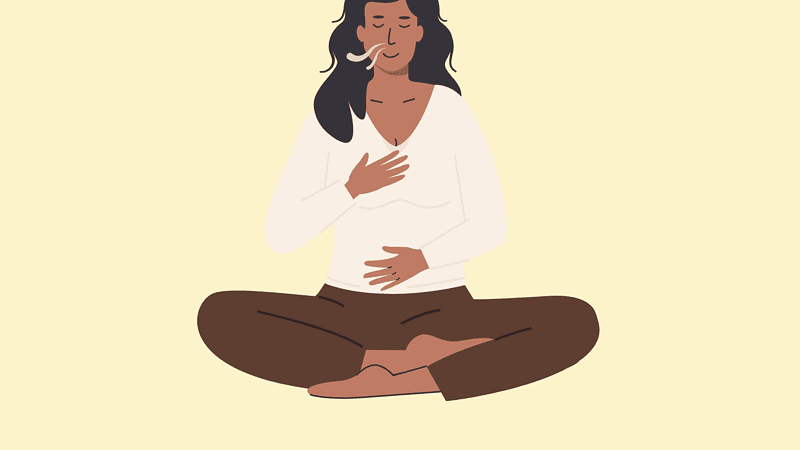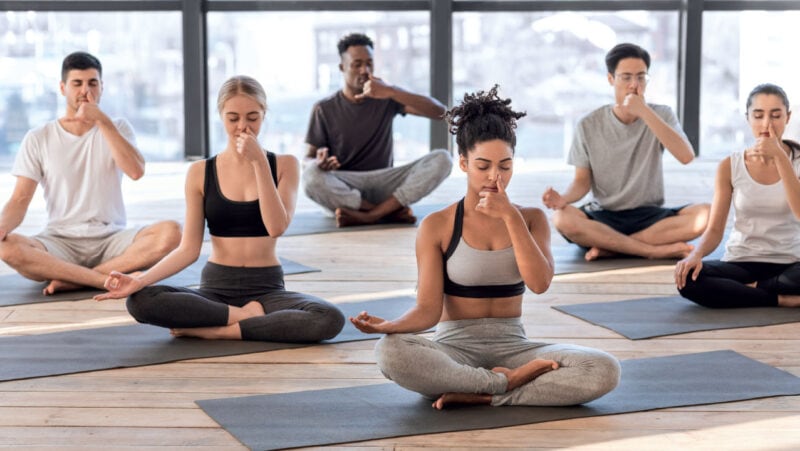
How to Practice and Teach Kapalabhati
This energising breathwork technique might do a better job of waking you up than your morning coffee - By Grace Haass
Reading time: 4 minutes
Most often, breathing happens naturally, without effort. Normal ventilation is an automatic process consisting of an inspiratory expansion and an expiratory contraction of the lungs, and a whole lot of other processes that happen during those two phases that we won’t get into. Even as we deliberately control the breath while practicing pranayama, most will have us controlling our muscles on the inhale, with the exhale happening without force. Kapalabhati (skull shining breath) is one yogic breathing technique that reverses that.
The exercise consists of rapid, forceful exhalations synchronized with abdominal contractions. In this pranayama, the inhalation is passive; the body intakes a small amount of air between exhalations once the contraction of the abdomen is released. Controlling the breath in this way causes a temporary withdrawal of the parasympathetic nervous system, producing a heating and energizing effect on the body rather than the cooling and calming effect that comes from long, slow, controlled inhalations during which the parasympathetic nervous system is activated.
Benefits of the Skull Shining Breath
In Sanskrit, “kapala” means “skull,” and “bhati” means “to shine.” This exercise is referred to as “skull shining breath” in English. It is one of the six yogic cleansing techniques called “shat kriyas.” As its name denotes, kapalabhati is said to cleanse the brain membrane and the organs within the skull (making them shine!). Studies have proven its numerous physical and mental benefits, such as:
- Activating the dead space of the lungs, which in turn improves the oxygenation of tissues
- Toning the abdominal muscles
- Massaging the liver, pancreas, and stomach to aid digestion
- Increasing blood circulation
Studies have concluded that 5 minutes of kapalabhati is in some ways equivalent to performing 30 minutes of cardiovascular exercise. Changes to HRV during the practice of this breathing technique are similar to that which occur during exercise, and the cardiovascular improvement from the technique is also significant. Therefore, those who are physically limited and cannot perform physical exercise may receive similar benefits by incorporating this pranayama into their lives.
How to Perform Kapalabhati
- Find a comfortable seated position with your legs crossed and your hands resting on your knees
- Ensure your spine is tall and straight.
- Lift your chin slightly
- Close your eyes and your mouth.
- Inhale deeply through the nose.
- Exhale repeatedly through the nose in short, forceful bursts, contracting your abdomen as you do so (pulling the navel towards the spine) and releasing the contraction quickly between bursts (this is when you will passively inhale)
- After 20 bursts of exhalation, return your breath to normal for 15-30 seconds.
- Repeat two more rounds of 20 short exhalations (3 rounds total).
Tips for Performing Kapalabhati Pranayama
Here are a few tips and tricks to help you get the hang of and intended benefits of this breathing technique.
Elevate Your Hips
Sit on a block or a bolster to give your spine more length and/or relieve knee discomfort.
Build Core Strength
In order to maximize the benefits of the contractions, it’s important to have strong abdominal muscles. To build/develop your kapalabhati practice, incorporate core-activating poses in your yoga practice.
Isolate the Movement to Your Abdomen
Try to keep the rest of your body still. Your first attempt might have you wanting to bring your shoulders into it (lifting them on the inhale and then pushing them down with each exhale) or even the muscles of the face/neck (I often find myself furrowing my eyebrows!). The contraction of the abdomen is what brings the deep expulsion of carbon dioxide and the benefits of that.
Start Off Slowly
After nailing the movement with practice, increase the speed of your inhalations slightly with each round.
Meet Yourself Where You Are
Start with the number of exhalations that feels attainable to you comfortably. Although 20 is an oft-recommended number, the right number for you is completely dependent on where you’re at in your practice. You will build stamina over time and can gradually increase the exhalations (up to 120 breaths/round).
Tips for Teachers
-
Perform a demonstration for one round of 5-8 exhalations before guiding the class through it.
-
Many beginners won’t know how to isolate the movement of their abdomen; to help them get a feel for it, have them place one hand on their lower belly. Repeat the instructions, queuing them to gently press their hand against their lower belly on the exhale/contraction and then to release the press so the belly expands to refill with a small amount of air (the inhale). Feeling the movement of their hand should help them understand the intended motion of the abdominal muscles.
-
Wear a tight-fitting shirt so your students can better see the movement of your abdomen during your demonstration.
-
After you’ve counted to 20 exhalations, wait another 5 seconds for most students to finish before cueing students to return their breath to normal for a few moments before the next round (some students will lose count, so this will be a good stopping point for them). Then cue them to begin round 2, and so on.
-
Don’t close your eyes or actually practice while teaching; your job as a teacher is to survey the class and make sure all of your students are following.
Who Should Not Do Kapalabhati Pranayama
As with many pranayama, kapalabhati does have a few contraindications. Individuals with high or low blood pressure, epilepsy, heart disease, gastric ulcers or any other abdominal complications, or eye issues (such as glaucoma or detached retina) should not practice this breathwork.
If you fall into any of these categories, don’t be discouraged, though! Instead, try nadi shodhana (alternate nostril breathing), one of the most well-known pranayama with no contraindications.







